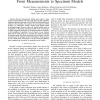Free Online Productivity Tools
i2Speak
i2Symbol
i2OCR
iTex2Img
iWeb2Print
iWeb2Shot
i2Type
iPdf2Split
iPdf2Merge
i2Bopomofo
i2Arabic
i2Style
i2Image
i2PDF
iLatex2Rtf
Sci2ools
ICC
2009
IEEE
2009
IEEE
Spatial Statistics of Spectrum Usage: From Measurements to Spectrum Models
—Several measurement studies have found a large amount of underutilized radio spectrum. More flexible regulation employing dynamic spectrum access (DSA) has been proposed as solution to this problem. The analysis of several aspects of DSA systems, e.g., cooperative sensing, requires good spatial models of spectrum usage. However, only very focused models such as propagation or shadowing correlation models exist. In this paper we apply techniques developed by the spatial statistics community to the modelling of spectrum. In more detail, we use random fields and the semivariogram to describe the spatial correlation of spectrum usage. We extract parameters from extensive real-life measurements for multiple wireless technologies. These parameter sets enable other researchers to use the model for different tasks ranging from theoretical to simulation-based studies.
Communications | Dynamic Spectrum Access | ICC 2009 | Spectrum Usage | Underutilized Radio Spectrum |
| Added | 21 May 2010 |
| Updated | 21 May 2010 |
| Type | Conference |
| Year | 2009 |
| Where | ICC |
| Authors | Matthias Wellens, Janne Riihijärvi, Martin Gordziel, Petri Mähönen |
Comments (0)

